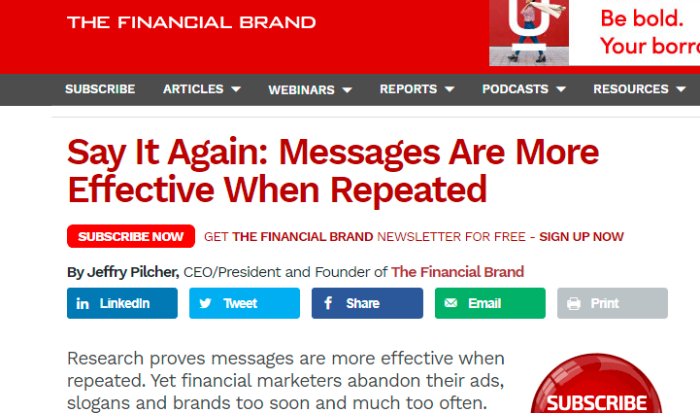
This article will get into some of the advertising and marketing techniques employed to get people to purchase products and services. There is quite a lot of science and research behind it.
1. Important Links
Alex Cattoni On Creating Scarcity Conditions
Justin Atlan On Scarcity To Create Sense Of Urgency
https://en.wikipedia.org/wiki/Artificial_scarcity
Psychology Today: The Scarcity Mindset
Investopedia On Suggestive Selling
Product Placement Strategies, History
Marketing Plans Should Include Sponsorship
Psychology In Advertising: Common Methods
CTV: Culture Shift On Wearing Masks
2. Techniques To Create Scarcity Illusion
- Price Scarcity — the price will increase
- Quantity Scarcity — limited amount available
- Premium Scarcity — limited time bonuses
- Offer Scarcity — relaunching a temporary product
Now, these specific techniques can be used individually, or in some combination, depending on the circumstances. The point of this is to put pressure on people to act now, or else the offer will never be better. While the creator, Alex Cattoni, says to be honest, artificially creating scarcity can be very manipulative nature. This type of pressure can be applied almost universally, although the specific methods vary. Justin Atlan talks about using scarcity in order to drive up sales.
Of course, artificially creating scarcity can be done for many reasons, and several of them are quite valid and legitimate.
This is from Wikipedia. There are perfectly valid reasons to engage in the creation of scarcity, such as intellectual property, and not undercutting your own prices. That said, there are unscrupulous ones as well.
Economics is the study of how we use our limited resources (time, money, etc.) to achieve our goals. This definition refers to physical scarcity. In a recent book titled Scarcity, Mullainathan & Eldar (2013) broaden the concept of scarcity by asking the following questions: What happens to our minds when we feel we have too little? How does the context of scarcity shape our choices and our behaviors? They show that scarcity is not just a physical limitation. Scarcity affects our thinking and feeling. Scarcity orients the mind automatically and powerfully toward unfulfilled needs. For example, food grabs the focus of the hungry. For the lonely person, scarcity may come in poverty of social isolation and a lack of companionship.
The scarcity mentality is well known by social psychologists. It forces being to think in finite terms, and to ask what they are missing out on. This can be good or bad, depending on the circumstances.
3. Fear Of Missing Out On A Benefit
FOMO, or the fear of missing out, is commonly used to pressure people into buying good and services now. Notice, it doesn’t have to be the product itself. It can just be having their life back to the way that it used to be. Perhaps something happened recently to change what was considered normal.
4. Suggestive Selling/Upselling
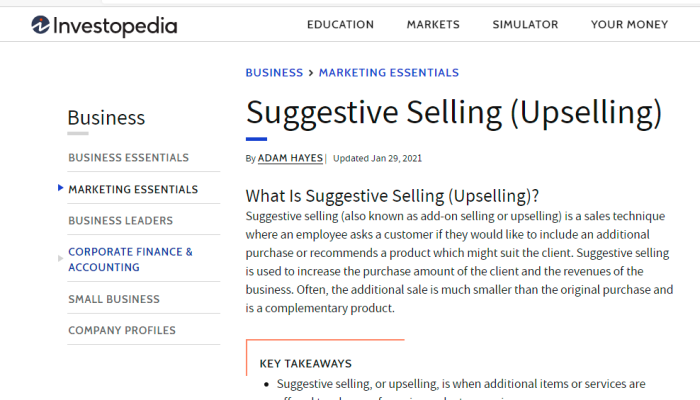
Understanding Suggestive Selling
The idea behind the technique is that it takes marginal effort compared with the potential additional revenue. This is because getting the buyer to purchase (often seen as the most difficult part) has already been done. After the buyer is committed, an additional sale that is a fraction of the original purchase is much more likely.
Typical examples of add-on sales are the extended warranties offered by sellers of household appliances such as refrigerators and washing machines, as well as electronics. A salesperson at an automobile dealership also generates significant add-on sales by suggesting or convincing a buyer sitting at their desk that the buyer would be much happier with the car with a few or several add-on options.
Investopedia explains that upselling it often considered a better use of a person’s time that focusing solely on new customers. After all, the person is already buying something, so why not take the minimal amount of effort to see if they will purchase anything new?
There is of course the idea of a volume discount. For example, take the BOGO (buy one, get one) free or greatly reduced. Often, people who may not have been willing to take multiple products now will, if it appears to reduce the price per unit.
5. Product Placement As A Sales Strategy
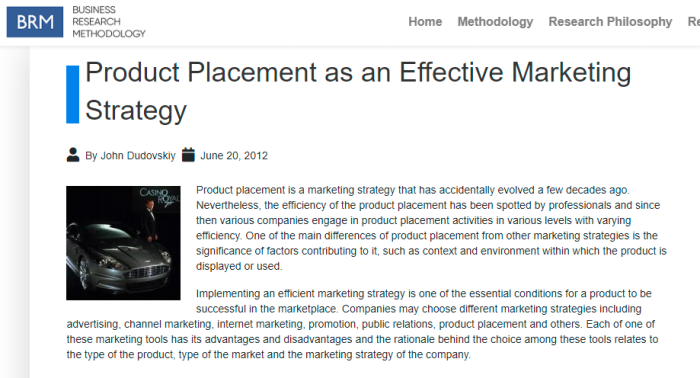
Product placement is a marketing strategy that has accidentally evolved a few decades ago. Nevertheless, the efficiency of the product placement has been spotted by professionals and since then various companies engage in product placement activities in various levels with varying efficiency. One of the main differences of product placement from other marketing strategies is the significance of factors contributing to it, such as context and environment within which the product is displayed or used.
Implementing an efficient marketing strategy is one of the essential conditions for a product to be successful in the marketplace. Companies may choose different marketing strategies including advertising, channel marketing, internet marketing, promotion, public relations, product placement and others. Each of one of these marketing tools has its advantages and disadvantages and the rationale behind the choice among these tools relates to the type of the product, type of the market and the marketing strategy of the company.
Product placement is a long recognized trick for getting a product into another production, without directly admitting that it is a form of advertising. This may be a substitute for more blatant ads, or may work in conjunction with it.
6. Keep Repeating Your Talking Points
This comment was (supposedly) in the context of pushing the climate change agenda on Canadians, but the principle can be applied much more broadly. It’s a variation of “if you tell a lie often enough, it becomes the truth”. Unfortunately, this is all too true.
7. Including Sponsorship In Marketing Plan
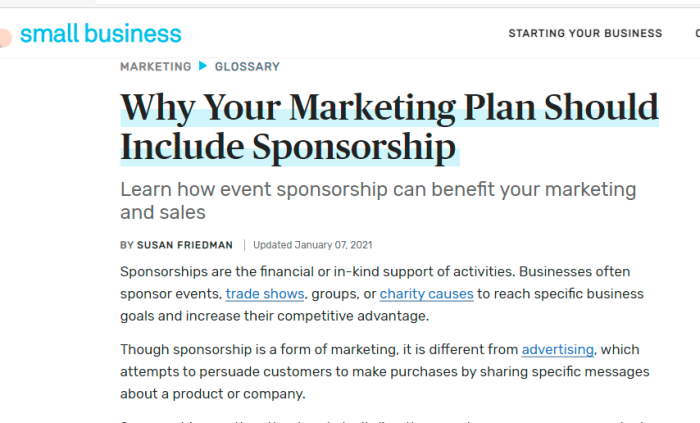
- Shape consumer attitudes.
- Build brand awareness.
- Drive sales.
- Increase reach.
- Generate media exposure.
- Differentiate yourself from competitors.
- Take on a “corporate citizen” role.
- Generate new leads.
- Enhance business, consumer, and VIP relationships.
Sponsoring a group or event can bring several benefits to your group, and those are outlined pretty well. Yes, the benefits are more intangible and difficult to measure, but it’s commonly believed to be an effective practice.
8. Pay For Advertising, Sponsoring In Media
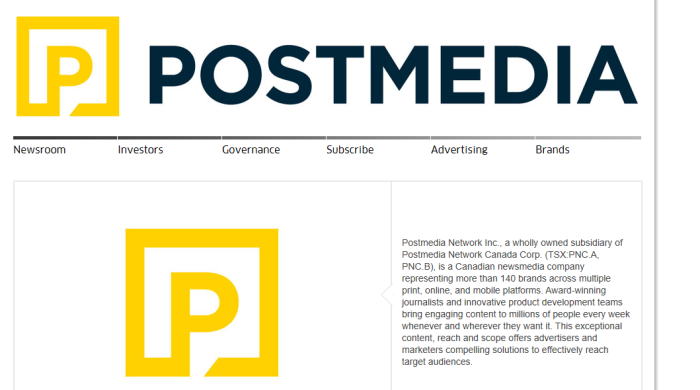

(a) Subsidization Programs Available For Media Outlets (QCJO)
(b) Political Operatives Behind Many “Fact-Checking” Groups
(c) DisinfoWatch, MacDonald-Laurier, Journalists For Human Rights
(d) Taxpayer Subsidies To Combat CV “Misinformation”
(e) Postmedia Periodicals Getting Covid Subsidies
(f) Aberdeen Publishing (BC, AB) Getting Grants To Operate
(g) Other Periodicals Receiving Subsidies
(h) Still More Media Subsidies Taxpayers Are Supporting
(i) Media Outlets, Banks, Credit Unions, All Getting CEWS
Paying for advertisements in newspapers, magazines, radio stations, and online, is a long accepted way of getting a message out. It’s an effective way to promote a product, service, or ideology. Of course, Governments can go the extra mile and just outright subsidize such outlets. It’s a way to create financial dependence, and ensure that they will be obedient to whatever is needed.
9. Psychology Used In Selling To People

- Branding
- Give, Give, Give, Give, and Ask
- Power of Scarcity, FOMO
- Perceived Value & Pricing
- Power of Persuasion
- Power of Convenience
- Appeal To Morality
- Changing Language, Misusing Terms
Advertising is much more complicated than simply being interesting and visually appealing. There are plenty of mental and psychological ways to do this. After this, it’s impossible to view ads in the same way ever again.
10. Have Credible Actors Promote Message/Brand
One of the keys to an effective marketing program is to have believable and realistic actors selling the message. Getting caught out like this doesn’t help at all. From a casting perspective, Ontario Deputy Medical Officer Barbara Yaffe was an extremely poor choice. Health Minister Christine Elliott wasn’t a great selection either.
When the stakes are high, it’s essential to have actors and actresses who have read and understood their scripts. They will be better able to improvise when asked difficult questions. See here and here. Remember, even though the media questions are screened, sometimes they will accidently be curveballs.
BC Provincial Health Officer Bonnie Henry is also a bizarre choice. While she seems likeable, and has the fake trembling nailed, she frequently jokes about the “no science” part. Perhaps she was never informed that this is serious.
Alberta Premier Jason Kenney may have topped them all. He admits there could be 90% error — and hence, no pandemic — but then defers to the experts.
Granted, these are difficult roles to play, given the scrutiny they are under. But still, the casting left a lot to be desired.
11. Why Does This Marketing Info Matter?

Even back in May 2020, the MSM in Canada was openly talking about “shifting the culture” to get everyone wearing masks for the foreseeable future. Of course, this sort of predictive programming is not limited to masks, but spread to other areas.
Imagine a group of people not driven by money, but by ideology. They wanted to convince the general population to inject — en masse — an experimental mRNA vaccine, to cure a disease they don’t know exists.
Such a task would be very difficult to accomplish, without using brute force. An alternative solution would be to apply some of the techniques outlined above, and get people to take it willingly.
As for appealing to morality, does this sound familiar?
“My mask protects you, and your mask protects me”.
Words and terms are redefined in false and misleading ways.
It’s not “martial law”, it’s “sheltering in place”.
Healthy people should not be viewed as normal.
Instead, they are “potential asymptomatic spreaders”.
The Federal and Provincial Governments are not buying off media outlets and businesses into compliance. Instead, they are handing out “emergency relief”. See the difference?
FOMO, or fear of missing out is being applied as a hardball tactic to get more people into taking the vaccine. After all, who isn’t desperate for some return to a normal life? If there aren’t enough to go around, doesn’t that create artificial scarcity?
Covid internment camps are a conspiracy theory. Those “mandatory isolation centres” are not at all the same thing, and people need to stop misrepresenting the truth.
No one is trying to trick citizens into taking the vaccine. Instead, they are just conducting research into ways to overcome “hesitancy”. See Part #1, #2, #3, #4 and #5.
Regarding hope for the future: an astute person will note that Canada has ANNOUNCED a program to compensate people for injury or death caused by vaccines. However, there have been no DETAILS of what it will look like. It could be the Government falling behind, or it could be tat they have no intention of implementing anything.

As soon as I saw this post, my first thought was the so called “Covid-19 vaccine”. It’s remarkable that we are experiencing such shortages – right?
I would bet there are multi millions of doses in storage, just waiting for the precise time to deploy the jabs. It takes a while to prime the audience and set up numberous venues like Wonderland to pull off this massive program.
My question is – will people be fighting in long line ups for this shot ?
For those that answer yes, please note that SARS-COV-2 has not been isolated, the PCR test is a fraud, the new “variants” are a lie to keep you in fear, masks are useless other than will make you sick, and this experimental biological agent jab is the largest human experiment about to be rolled out to an uneducated population. It won’t end well!
The vaccine wasn’t created for the virus.
The virus was created for the vaccine.
Also aligning with comment above , they need to prolong the vaccination rollout in order to justify the continuation of the masks and other charter violations throughout the summer season. Then flu season will begin again in the fall and soon it will be two full years and the insanity will become normalized in the zombies.
What concerns me about the variants is that they aren’t talking about the variants of no concern and so the general population is largely unaware of how prevalent these variants of no concern may be and this could lead to many people becoming asymptomatic spreaders of these variants of no concern and with exponential growth these variants of no concern could soon become the dominant strain. Very concerning indeed
Pathogenic priming is what this is. This gene “therapy” masquerading as a vaccine, causes the immune system to over react to corona like viruses. Probably going to have an avalanche effect this cold and flu season. So hospitals will be legitimately over-run with sick and dying (everyone who took the jab).
Bet the “heros” won’t have time to make tic tok videos then.